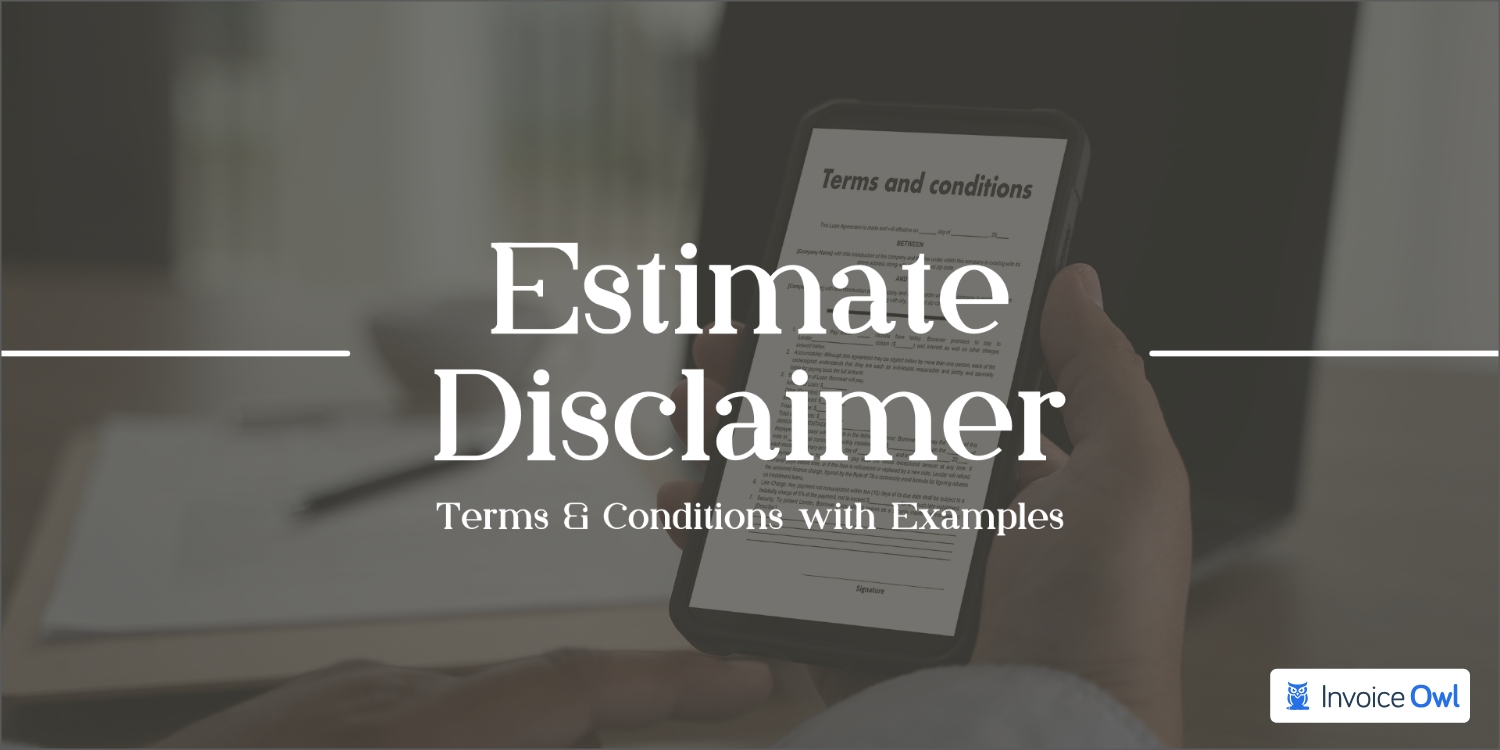

This article aims to provide detailed information on estimate disclaimers. It also focuses on some examples of industry-specific terms and conditions you might wish to include in your estimates, along with general terms and conditions. The article also aids in providing knowledge of drafting any estimate terms and conditions; you should adhere to some fundamental best practices.
If you run your own business, it is crucial to provide services to your customers on time. After all, you must maintain your company’s operations and ensure that your workers are paid for their efforts.
In an ideal world, every client would pay you promptly when you complete a project and in full. But regrettably, that doesn’t always happen.
The process of obtaining estimates and receiving payment can be sped up and clarified by putting terms and conditions in your estimates.
The obligations for both you and the client are outlined in the terms and conditions, the services you’ll offer, and their associated costs.
Establishing clear expectations at the outset of your engagement helps prevent future customer issues.
Continue reading to discover how to write estimates and various estimate disclaimers.
Table of Content
Estimates are a regular practice in the corporate world, especially in some industries. You must publish a document outlining the price you anticipate your client will have to pay for your services or commodities when the actual cost cannot be determined upfront.
Even though this isn’t a contract, it’s a good idea to include an estimate disclaimer to prevent misunderstandings. Numerous payment terms and conditions and additional services may change over time depending on various factors.
You can see from an estimate disclaimer sample that it might concentrate on the estimate’s price, the detailed estimate terms of payment or delivery, the design, or any other aspect that cannot be determined at the outset.
You might need to add unique disclaimers in your estimates for the services you offer because every sector is distinct.
Here are some examples of industry-specific estimate disclaimers you might wish to include in your estimates, along with general terms and conditions.

The following disclaimers are frequently included in plumbing estimates:
The following disclaimers are frequently included in handypersons’ estimates:

Estimate disclaimers from carpenters and woodworkers may contain the following:
Electricians occasionally include the following disclaimers in their terms and conditions:
Some service providers in the construction industry employ the following clauses:

The usage of copyright disclaimer guards against user theft of original content. It explains that everything on your website is your property and that utilizing it illegally will have legal ramifications.
Any creative work that exists in a tangible form qualifies as a copyright example. A work is automatically protected by copyright as soon as it is created and made reproducible.
Therefore, a specific copyright disclaimer is not legally necessary, but it is a powerful deterrent against copyright infringement which customer agrees to. It displays your legal knowledge and commitment to upholding your position.
A copyright disclaimer can be used to prove ownership of original content and stop users from profiting financially from your labor of love.
A fair use disclaimer is necessary if your website or app incorporates content from other sources to protect your company from copyright infringement claims.
According to the fair use concept, works protected by copyright may be used in specific situations without the owner’s consent.
Take the following actions to defend your company against charges of copyright infringement:
Some content, such as private information in an email, is only meant to be seen by a specific audience, as explained by confidentiality disclaimers.
A confidentiality disclaimer informs the recipient who the communication is for, why they shouldn’t forward it to others, and whom to contact if they unintentionally receive it.
Law, education, and healthcare are three fields that depend on the exchange of private data and frequently use confidentiality disclaimers. For instance, they come in handy when a company has to guarantee the attorney-client privilege, protect sensitive personal information, or safeguard confidential health records.
Since every company is different, not all sets of terms and conditions will be the same. Terms for a photography firm will cover different subjects than, say, those needed by a healthcare organization. However, while drafting any estimate terms and conditions, you should adhere to some responsible and fundamental best practices.
Use a template like the free estimate template to ensure your document is presented properly and professionally. You can include terms and conditions in the “Notes” section of the template. Consistency is further ensured by using a template. Since just a few essential variables, including the client name and project specifications, need to be altered each time, you can make estimates more rapidly.
Your estimate must include a price, general estimate terms, and some basic payment information. It’s significant to remember that your estimate’s pricing is “subject to change.” It will safeguard your small business from pricing changes. For instance, if you’re a small business owner and need to purchase lumber to finish a project, you have no control over the final price of lumber (which your estimate will consider).
Additionally, you might want to note how any labor or price modifications will be billed. You can refer to such changes and fluctuating prices for direction if the task is more challenging than anticipated or the client’s requirements alter.
You can add terms and conditions of your large or small business near the end. You should include all applicable project elements, additional expenses, price variations, additional information and sector-specific acceptable methods, terms and conditions.
Below are a few samples of various terms and conditions that you can use as models, modify for your requirements, or copy and paste if appropriate.
Even though there isn’t a formal contract between you and your client, you should always present yourself professionally. The details listed below should be present in a well-designed estimate template:
As long as they are a part of a contract, disclaimers are legally binding. A contract requires the following elements to be present:
The easiest method to ensure that your client completely understands the payment terms and conditions of your collaboration is to include an estimate disclaimer in the paper that you provide them with a fixed price quotation.
Although not all disclaimers are legally enforceable, they are nonetheless highly helpful in guaranteeing clear communication and preventing unnecessary disputes if the rates alter for a valid reason.
To streamline this process, consider using InvoiceOwl, an effective estimate and invoice software. InvoiceOwl simplifies creating and managing estimates and invoices, ensuring your clients always have clear and accurate information. This software helps you maintain transparency, avoid misunderstandings, and manage your billing efficiently.
Easy-to-use, mobile estimating and invoicing software, InvoiceOwl was created with simplicity in mind.
They provide a 14-day free trial, so give it a shot and start creating estimates now!
Author Bio Jeel Patel FounderJeel Patel is the founder of InvoiceOwl, a top-rated estimating and invoicing software that simplifies the invoicing and estimating processes for contractor businesses. Jeel holds a degree in Business Administration and Management from the University of Toronto, which has provided him with a strong foundation in business principles and practices. With understanding of the challenges faced by contractors, he conducted extensive research and developed a tool to streamline the invoicing and estimating processes for contractors. Read More

Get weekly updates from InvoiceOwl.